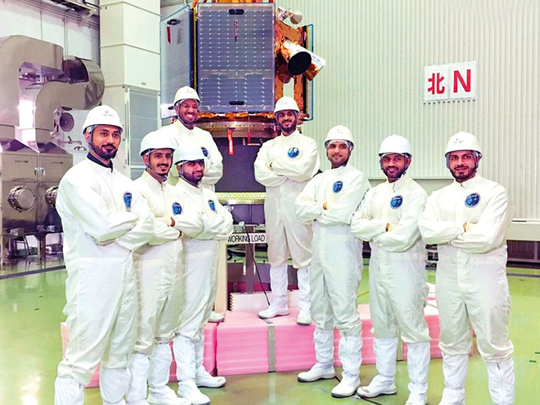
Dubai
Back in university, Abdullah Al Shehi worked on the UAE’s first nanosatellite. The project sparked his love for space tech that made him part of the 70-member team that built the country’s first purely Emirati-made satellite, the KhalifaSat.
The senior mechanical engineer’s role was to design and analyse the structure of KhalifaSat that’s due for launch tomorrow. He also supported the assembly of the spacecraft.
“My senior design project was Nayif-1, the first UAE cube satellite. This was my senior exam before graduating from university. I had the passion to continue working on space tech; it was very new in the UAE then,” Al Shehi, 26, told Gulf News.
He was among the first generation of Emiratis to receive the transfer of knowledge by the first batch of 10 Mohammad Bin Rashid Space Centre (MBRSC) engineers who worked and studied in South Korea in 2006 to build the DubaiSat-1 and DubaiSat-2.
- Abdullah Al Shehi | Senior mechanical engineer
Coming from a family of engineers, building something worthwhile came naturally for Al Shehi. But the long hours of work - in and out of the clean room where the satellite was built - was what he found most challenging.
“We had to finish everything on a strict deadline. So we would start work at 6am and finish at around 3pm or 4pm. The most critical part is while doing the assembly itself. So you have a very long procedure. Even while doing the assembly, you have to write down every step and anything that changes.”
The task was so challenging, it follows them in their dreams sometimes.
“We have a joke in the mechanical section — if you’re not dreaming about the project, then you’re not doing it right,” said Al Shehi. But jokes apart, he said they were able to maintain work-life balance because the project was planned and managed well.
Now that his “baby”, KhalifaSat, is ready for launch, every effort was worth it, he said.
“We consider KhalifaSat as the backbone of this space centre. In the beginning, many people said [our project] was impossible. They called it the impossible journey. However, KhalifaSat is now ready to launch, so nothing really is impossible.
“If you put your heart and soul into something, you can achieve it, maybe not today, not tomorrow, but eventually you’re going to achieve it. Now, we’re ready for the next project,” said Al Shehi.
Reem Rashid Al Mehsini
By Janice Ponce de Leon, Staff Reporter
Dubai
For a nuclear engineer who got into space tech engineering as her first job, the shift was nothing less than stimulating and rewarding.
Reem Rashid Al Mehisni, 24, was one of the team of engineers who laboured tirelessly to make the KhalifaSat launch-ready.
Reem’s role was to do a detailed thermal analysis simulation of the KhalifaSat, install the thermal control subsystem hardware, and conduct thermal tests. These steps are done to make sure that the spacecraft’s temperature will be maintained within the specified limit in all the mission phases—during launch, through the travel, until it goes to space.
Because of their work, the clean room essentially became their second home.
“Working in the lab was very interesting. We were first designing the satellite and planning for our system using a software. So we were just imaging it seeing it from the software. When we moved to the lab, it was where we had hands-on work and transformed the design from paper into the actual satellite. This was the most interesting part for me,” she said.
It was in the clean room also where Reem faced and overcame many challenges, some of which she can still recall vividly.
“The part that I won’t forget was when we conducted the environmental tests for the spacecraft. It was a very stressful moment. But at the same time, it had its unique feel to it as it was a great experience,” Reem told Gulf News.
“I loved how the team worked as one spirit to solve the issue on the spot within just hours. I also discovered strong points within myself being an engineer in solving problems. This is something I will never ever forget,” she added.
The KhalifaSat became was her “baby” at work while she was also carrying her first baby, literally.
“I was working in the lab while I was pregnant so she was part of the project. When I did that unforgettable thermal test, she was with me. So she knows everything about KhalifaSat,” she said with a smile.
“After I finished everything, I gave birth. She is a baby girl and she is three months old now.”
Reem is confident the KhalifaSat will be a successful mission for the UAE. The feeling of excitement seeing the satellite ready for launch is very rewarding.
She hopes other young Emiratis would also consider getting into space tech engineering, too.
“They can succeed in anything they want to be if they’re working sincerely. They just have to be sincere with their work. It’s a very interesting field and it’s really where they can apply their engineering skills and knowledge. It’s not routine at all. Every project has its uniqueness. It’s like an adventure every day. The challenges are not always the same. So it’s like every day you’re discovering yourself getting stronger and excelling in this field.”








